Possessions are something that the dead can’t take away with them. Therefore this calls for the requirement of inheritances that needs prior planning. Choosing the right person who will take care of the assets and the possessions after the owner’s demise is essential. If one dies intestate, the law might not consider their personal choices or relationships during asset distribution. Therefore, estate planning is deemed necessary to keep it protected within the familial boundary. One should always seek the assistance of an experienced and knowledgeable attorney from Scott Counsel before engaging in estate planning, who would offer proper guidance and advise the best ways to make the most out of it.
But prior knowledge of the entire estate planning procedure would be plus, even before consulting an attorney. Here’s a detailed explanation of how the process might look like.
Table of Contents
Initial Consultation With An Attorney:
Choose an attorney who has experience in the field of estate planning and trusts, as they can offer the best legal advice. The initial consultation will be just an introductory meeting with preliminary discussions regarding what should be done with the assets and the money or the numerous options available to protect it. Also, discussions regarding wills and deeds, attorney fees, and the power of the lawyer might be a part of this.
Preparation Of Draft:
Once everything is agreed upon, things will be taken forward by the attorney. For this, some more information concerning the family asset should be provided to the lawyer, who would prepare an initial draft. Along with these, the attorney might also ask for a list of the securities, bank accounts, and properties that should be placed in the trust. Once the proposed document is prepared using all these inputs, the attorney will send them to the client for review.
Document Review:
The client must read the document thoroughly and approach the attorney if the draft needs changes. Once the attorney and the changes answer all issues or questions are made, the lawyer will prepare the final set of documents. A date will be fixed when the lawyer will meet the client to sign the document.
Final Thoughts:
Once the documents are signed and everything is ready, it’s time to transfer the securities, properties, and bank accounts to the trust. This action is referred to as funding the trust. Last but not least, the client’s bank and concerned security companies should be informed about the faith, which will come with their forms or signature cards that require the owner’s signature.




